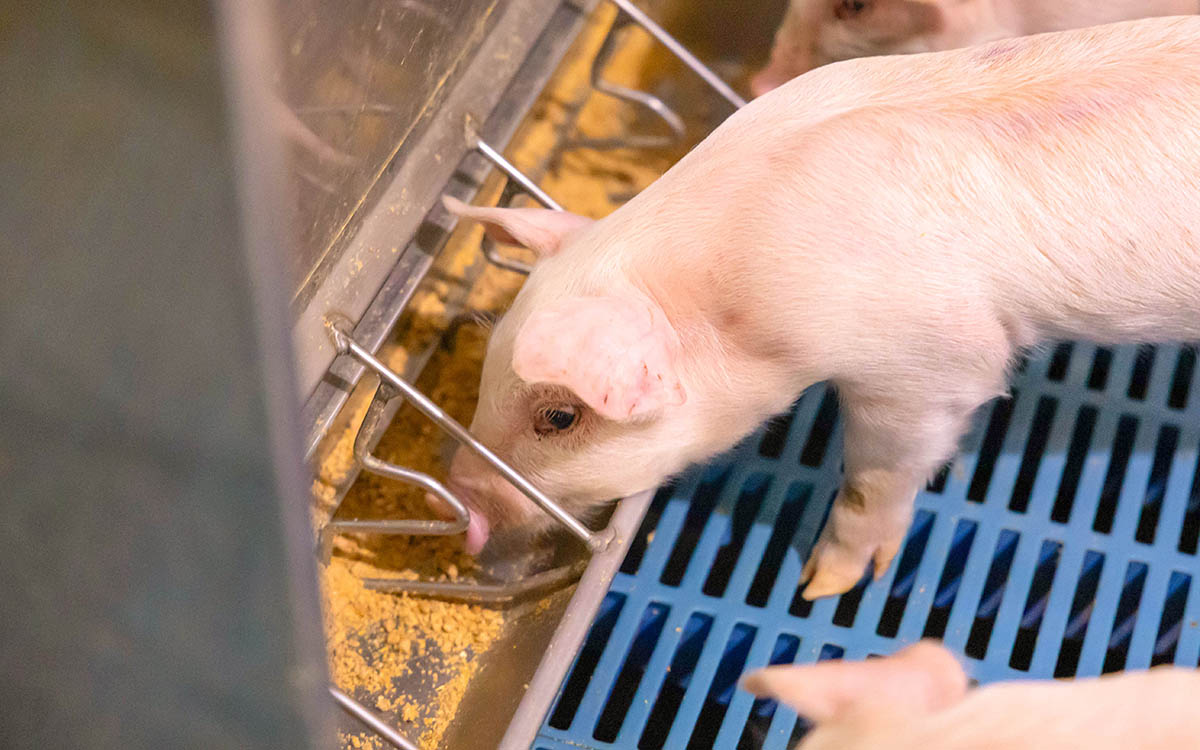
(Photo: Iowa Soybean Association / Joclyn Kuboushek)
Soy and swine: A winning partnership
October 16, 2025 | Kriss Nelson
October is National Pork Month, and it’s fitting to reflect on how the soybean and pork industries are related. Iowa farmers grow the soybeans that feed hogs, and those hogs, in turn, help support soybean prices.
“Soy and pork go hand in hand. One needs the other, so I call it a partnership,” says Story County pork producer and Iowa Soybean Association District 5 Director Dave Struthers.
Iowa is home to 24.7 million pigs as of June 1, 2025, according to the U.S. Department of Agriculture. Iowa farmers produce one-third of the nation’s hogs.
Grant Kimberley, ISA senior director of market development, says the pork industry ranks second among livestock users of soybean meal, making up about 17% of domestic demand. From farrow to finish, each 270-pound hog consumes roughly 2.5 bushels of soybeans. Pork exports the equivalent of more than 100 million bushels of U.S. soybeans each year, adding about $1.46 to every bushel grown.
“In Iowa, we’re at the center of it all,” says Kimberley. “Pork is our number one livestock sector, and soybeans remain one of our most important crops, and the two depend on each other.”
Checkoff dollars at work
The soybean checkoff is working to maintain that relationship. Through the United Soybean Board and state associations like ISA, checkoff investments support research focused on feed efficiency and nutrition.
This research ensures soy stays the go-to protein source in feed, helping livestock producers maintain healthy, productive herds while keeping soybean demand strong.
“We’re always working to find new ways soybean meal can perform even better in rations,” Kimberley says. “When meal prices are lower, that advantage becomes even stronger.”
Iowa soybean farmers also support the pork industry as strong supporters of the Animal Ag Alliance and founding members of the Coalition to Support Iowa’s Farmers. ISA also works closely with Iowa pig farmers as an active participant in the Iowa Food & Family Project, helping boost trust in modern agriculture and demand for great-tasting pork raised right here in Iowa.
ISA, Iowa Pork Producers Association and Iowa Corn are also founding partners of the Iowa Agriculture Water Alliance, working together to find new resources and innovations to improve water quality.
Essential nutrition
Soybean meal provides pigs with a high-quality, protein-rich feed source.
Struthers explains pigs require a high-protein diet, making soybean meal an ideal ingredient for his pigs.
“Soy, as it does for humans, benefits pigs,” says Struthers. “Some of the essential amino acids, antioxidants, and nutrients in soy are good for humans and also good for livestock. It’s the most available, most economical and most easily accessible protein source we can use.”
Struthers explains that he uses six feed rations to meet the nutritional needs of pigs as they grow from 30-pound weaned pigs to 300-pound market weight hogs.
“The soybean meal inclusion changes as they age, but it’s a necessity in livestock and pork production,” says Struthers. “They need protein and energy, and soy provides that.”
Kimberley says U.S. soybeans hold a reputation for consistent quality and high feed value, giving them a clear advantage worldwide.
In countries like Brazil, soybeans are frequently harvested damp and dried with heat — a step that can compromise quality, explains Kimberley.
“That process can lower the lysine-to-protein balance, meaning livestock feeders must add extra synthetic amino acids to maintain performance. U.S. soybeans, by comparison, hold their feed value naturally,” he says.
That consistency matters to livestock producers at home and pork buyers overseas. Kimberley notes that China remains a large market thanks to its massive hog industry, although U.S. soybean exports there have halted in recent months.
“At the same time, Southeast Asia and Latin America continue to show steady growth,” he says. “In countries like Vietnam, rising middle-class incomes and diets richer in protein are fueling fresh demand for both U.S. soybeans and pork.”
A promising outlook
Looking ahead, Kimberley says the outlook for soy and pork remains positive. As global economies grow and more consumers add meat to their diets, Iowa farmers are well-positioned to meet that demand.
“Expanding pork exports means more soybeans leaving the farm and not in a truckload of grain, but as a plate of pork somewhere around the world,” he says. “It’s one of those relationships that truly works both ways. When we export pork, we’re really exporting soybeans in another form.”
To learn more about Iowa’s pork industry, visit iowapork.org.
Written by Kriss Nelson.
Back